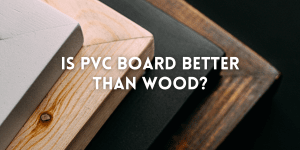Aug 08, 2022

Since time immemorial, human civilization has utilized two of nature’s resources to construct their homes and structures: stone and wood. Although they may vary in geographical abundance, the ubiquity of the latter would make the material one of the most sought-after construction supplies in the world. However, due to the world’s urgency to solve the depletion of forests and the continued technological innovations, homeowners and contractors have changed their preference to something else: the PVC board.
But is there merit to this new construction material that makes it superior to wood? Are there still advantages to using wooden boards and bars that should make PVC users think twice? For this article, we will look into their contrasting qualities and their respective pros and cons.
PVC stands for Polyvinyl chloride, but you might know this material by its generic name “vinyl”. It is one of the most widely used synthetic plastics in the world. In terms of build, they can be either tough or malleable, depending on their use.
You may encounter them mostly in toys, furniture, hardware, and, most recently, in 3D-printed objects. In home and business construction, contractors and builders have utilized PVC materials on window framing, cable wiring, cabinetry, flooring, roof tiling, and ceiling boarding, among others.
Because of the material’s prevalence, it begs the question of people’s preference for it.
For one, PVCs are widely available and cheap in many home construction stores, and their malleability gives the material a high level of versatility.
In addition, PVCs, despite being lightweight and affordable, are some of the studiest and most resilient materials. They can resist damage that other materials experience from expansion, contraction, or corrosion caused by heat, moisture, and deterioration. It is quite durable and some sources suggest that it can last for up to a hundred years!
Lastly, manufacturers of PVC have suggested that the material has a more positive environmental impact in the long term, as it takes less energy and resources to produce them, and it is less likely that homeowners and business owners would need to replace PVC-made parts due to its durability, as previously mentioned.
With all that said, it is not without some issues, although these are negotiable for some. Depending on their manufacturing, PVC materials have varying resistance to hot and cold temperatures. The maximum temperature PVCs can tolerate is about 60°C, so consider this when purchasing PVC for plumbing and insulation. Furthermore, for affordable construction, PVCs are better applied in smaller projects like homes and small businesses, not for larger structures.
Despite the shift in market preference for PVC-made supplies, wood is still a widely favored resource in construction and maintenance, and its ubiquitous use can still be seen worldwide. Its timeless utilization is due to several advantages.
Although there is a valid worry about the depletion of our forestry, using wood for construction-related purposes still has a more positive environmental impact, as it produces fewer carbon emissions than using concrete and steel. Additionally, unlike concrete and steel, wood is overall a renewable resource.
Like PVC, wood is a lightweight but highly sturdy material, and, with the right engineering and manufacturing, can create a rigidly strong home. Not to mention, constructing homes with wood is an easier, cheaper, and less noisy process than others.
Of course, like PVC, it also has its disadvantages, mainly regarding damage susceptibility. For one, as we all know, wood is a highly flammable material, so when residing in a wooden home, it is best to be vigilant of potential fire hazards. Moreover, compared to synthetic materials, wood does not have a long life span, as it is more vulnerable, to deterioration from natural occurrences like rainwater, heat, and termites.
To avoid such incidences, be sure to monitor signs of damage early, and ensure that any part of the home constructed in wood stays clear from potential fires such as kitchen stoves and electrical outlets.
With all these details considered, what, then, is the recommended material for your home? The answer: it all depends on personal tastes and professional advice.
Do you need durable plumbing and insulation? You probably need PVC.
Are you doing a cheaper and more traditional construction project for your home? Go for wooden materials.
While our modern world continues to improve on the things we take for granted, we still return to the tools we have used since the very beginning. Choosing one over the other is not wrong, provided that you have the right knowledge of the supplies you need.
That said, after doing thorough research and accounting, your next step is finding the resources you will need, and you can find them at AllHome, your one-stop shop for your home-related needs. You can stop by the nearest branch or visit www.allhome.com.ph to conveniently shop online!
If you are interested in our tips and product recommendations, you can also like and subscribe to our official Facebook, Instagram, and Youtube pages!
Thanks for reading, have a nice day, and see you again in our next entry!
Customer Service Hotline: +63 968-2434-789